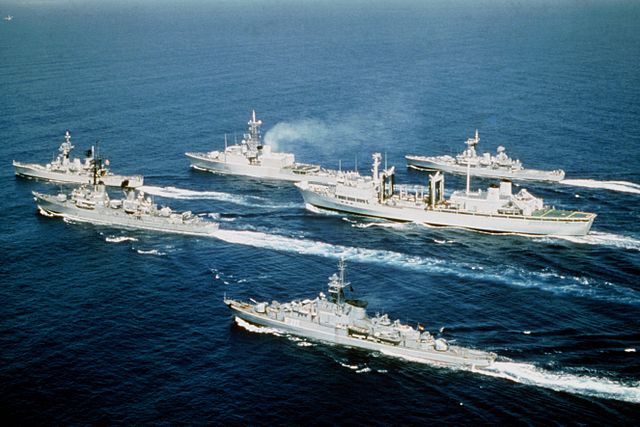Iroquois-class destroyers, also known as Tribal class or DDG 280 class, were a class of four helicopter-carrying, guided missile destroyers of the Royal Canadian Navy. The ships were named to honour the First Nations of Canada.
HMCS Algonquin
Huron in 1976 with split exhaust funnel, Sea Sparrow launcher on forward superstructure, and 5-inch (127 mm)/54-calibre gun on forecastle.
Athabaskan in 2009 – note one funnel and position of gun
STANAVFORLANT underway in 1982. Iroquois is centre top left.
The Royal Canadian Navy is the naval force of Canada. The navy is one of three environmental commands within the Canadian Armed Forces. As of February 2024, the RCN operates 12 Halifax-class frigates, 12 Kingston-class coastal defence vessels, 4 Victoria-class submarines, 4 Harry DeWolf-class offshore patrol vessels, 8 Orca-class patrol vessels, and several auxiliary vessels. The RCN consists of 8,400 Regular Force and 4,100 Primary Reserve sailors, supported by 3,800 civilians. Vice-Admiral Angus Topshee is the commander of the Royal Canadian Navy and chief of the Naval Staff.
HMCS Québec, formerly HMS Uganda, was one of many ships commissioned by the RCN in the Second World War. Expanding substantially during the war, the RCN had become the world's fifth-largest navy by 1945.
Four F2H-3 Banshee fly overhead HMCS Bonaventure. Bonaventure was the last aircraft carrier in service with the RCN.
HMCS Athabaskan departing Halifax for the Persian Gulf as part of the Coalition forces. Canada deployed three ships in support of Operation Desert Shield, and later Operation Desert Storm
CFB Halifax is the headquarters for RCN units from Maritime Forces Atlantic.








